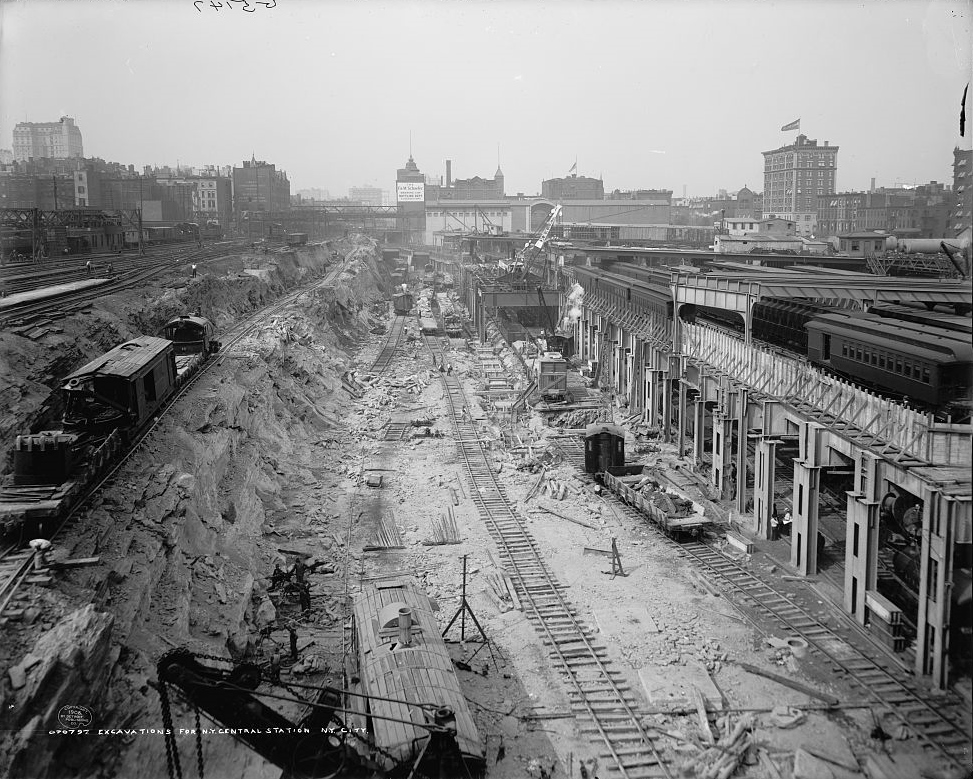NYC Hudson Locomotive, built with iconic Streamlining
designed by Henry Dreyfuss, used to haul
The 20th Century Limited Train, starting in 1938.
Photo courtesy SMU.
Date: 1938.
Source: Southern Methodist University, Central University Libraries, DeGolyer Library: Robert Yarnall Richie Photographs. Retrieved from Flickr: Hudson Locomotive for The New York Central.
Author: Robert Yarnall Richie (1908-1984).
(Wikimedia Commons)

English: Grand Central Station Terminal,
42nd Street, New York,
United States of America.
Français: Vue extérieure nocturne de la gare
Grand Central Terminal sur l'ile de Manhattan, à New-York (États-Unis).
Date: 1/08.
Source: Own work.
Author: Fcb981 ; Eric Baetscher (attribution required).
(Wikimedia Commons)

Excavations for New York Central Railroad Station.
Artist: Detroit Publishing Company.
Date: Circa 1908.
Current location: Library of Congress,
Washington D.C., United States of America.
Source/Photographer: This image is available from
The United States Library of Congress's
Prints and Photographs division
under the digital ID det.4a22981
(Wikimedia Commons)
"The Railroad Signal".
New York Central Railroad
Educational Documentary 1948.
Ella73TV.
New York Central Railroad Educational Documentary from 1948 that gives an overview of railroad signals and related safe working infrastructure used by trains, as well as the ongoing improvements to the signalling systems due to technological advances.
Available on YouTube at
Famous New York Central Trains:
New York to Chicago
20th Century Limited: New York to Chicago (limited stops) via The Water Level Route 1902–1967.
Commodore Vanderbilt: New York–Chicago (a few more stops) via The Water Level Route.
Lake Shore Limited: New York–Chicago via Cleveland with Branch Service to Boston and St. Louis 1896–1956, 1971–Present (Reinstated and combined with New England States by Amtrak in 1971).
Chicagoan: New York–Chicago.
Pacemaker: New York–Chicago All-Coach Train via Cleveland.
Wolverine: New York-Chicago via Southern Ontario and Detroit.

New York to Chicago
20th Century Limited: New York to Chicago (limited stops) via The Water Level Route 1902–1967.
Commodore Vanderbilt: New York–Chicago (a few more stops) via The Water Level Route.
Lake Shore Limited: New York–Chicago via Cleveland with Branch Service to Boston and St. Louis 1896–1956, 1971–Present (Reinstated and combined with New England States by Amtrak in 1971).
Chicagoan: New York–Chicago.
Pacemaker: New York–Chicago All-Coach Train via Cleveland.
Wolverine: New York-Chicago via Southern Ontario and Detroit.

St. Louis Union Station.
Missouri, United States of America.
The New York Central Railroad's Knickerbocker Train
and The Southwestern Limited Train
ran between New York and St. Louis.
Photo: 12 May 2015.
Source: IMG_0693
Author: Dustin Batt
(Wikimedia Commons)
Chicago Mercury: Chicago-Detroit.
Cincinnati Mercury: Cleveland-Cincinnati.
Cleveland Mercury: Detroit-Cleveland.
Detroit Mercury: Cleveland-Detroit.
New York to St. Louis.
Knickerbocker: New York–St. Louis.
Southwestern Limited: New York–St. Louis.

Michigan Central Station's Beaux-Arts façade.
The New York Central Railroad's Michigan Train
ran between New York and Michigan.
Photo: August 2008.
Source: Own work.
Author: Urbanarcheology.
(Wikimedia Commons)

Photo of the Streamlined New York Central Train, "The 20th Century Limited", leaving Chicago's LaSalle Street Station on a trial run 9 June 1938. The Train was put into Service on 15 June 1938. This Train was a famous New York Central Railroad Train which ran from 1902-1967.
Source: eBay
Author: Associated Press.
(Wikimedia Commons)
Other Trains
Empire State Express: New York-Buffalo and Cleveland via The Empire Corridor 1891–Present.
Ohio State Limited: New York-Cincinnati via Empire Corridor.
Xplorer: Cleveland-Cincinnati 1958–1960 (Special experimental Lightweight Train).
Cleveland Limited: New York–Cleveland.
Detroiter: New York–Detroit.
James Whitcomb Riley: Chicago-Cincinnati.
Michigan: Chicago-Detroit.
Motor City Special: Chicago-Detroit.
New England States: Boston-Chicago via The Water Level Route 1938–1971. (Retained by Penn Central and, for Amtrak, combined with re-instated Lake Shore Limited).
Twilight Limited: Chicago-Detroit.
Trains left from Grand Central Terminal in New York, Weehawken Terminal in Weehawken, New Jersey, South Station in Boston, Cincinnati Union Terminal in Cincinnati, Michigan Central Station in Detroit, St. Louis Union Station, Missouri, and LaSalle Street Station in Chicago, Illinois.
PART FOUR FOLLOWS


No comments:
Post a Comment